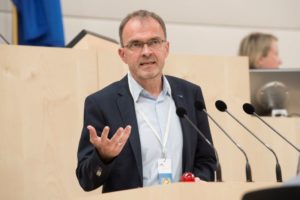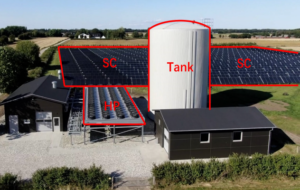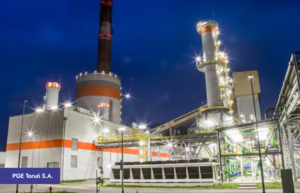

Denmark/Germany: Consumer-Owned Utilities Spearhead Energy Market Transformation
 Solar district heating is becoming increasingly attractive to small towns and municipalities which are looking for energy independence and stable heat prices, a trend which was discussed at length during the October webinar by the International Solar Energy Society (ISES). Entitled Renewable district heating – Small local grids and cooperative utilities, it offered an opportunity for German and Danish experts to present successful case studies, underline the political frame conditions which foster renewable integration into district heating and explain the advantages of cooperatives (recording available online). The photo shows the experts participating in this first webinar of a three-part series coordinated by Riccardo Battisti, Head of EU Project SmartReFlex: Per Alex Sørensen and Per Kristensen from Denmark as well as Oliver Miedaner from German Solites (from left). The second webinar – Think big: Design rules and monitoring results of solar district heating systems – will be organised in cooperation with solarthermalworld.org and is scheduled for 6 December (online registration).
Solar district heating is becoming increasingly attractive to small towns and municipalities which are looking for energy independence and stable heat prices, a trend which was discussed at length during the October webinar by the International Solar Energy Society (ISES). Entitled Renewable district heating – Small local grids and cooperative utilities, it offered an opportunity for German and Danish experts to present successful case studies, underline the political frame conditions which foster renewable integration into district heating and explain the advantages of cooperatives (recording available online). The photo shows the experts participating in this first webinar of a three-part series coordinated by Riccardo Battisti, Head of EU Project SmartReFlex: Per Alex Sørensen and Per Kristensen from Denmark as well as Oliver Miedaner from German Solites (from left). The second webinar – Think big: Design rules and monitoring results of solar district heating systems – will be organised in cooperation with solarthermalworld.org and is scheduled for 6 December (online registration). “Today, you’ll find 340 user-owned cooperatives, which cover 30 % of the district heating demand in Denmark,” Sørensen said. Based on his thirty years of experiences in energy planning and district heating, the consultant explained that cooperatives in heat supply had had a long history in the Scandinavian country. The first wave of user-owned district heating cooperatives was established in the 1960s when homeowners changed from individual boilers running on peat or coke to oil heaters or district heating. The second wave began in the 1990s when natural gas-fired CHP plants started to push back coal ones. Since 2010, individual gas boilers have been replaced by gas and district heating plants sourcing renewable energy. This latest trend is supported by the country’s nationwide goal of achieving 100 % independence from fossil fuels in the national energy mix by 2050, as set forth in the 2050 Energy Strategy approved by the Danish parliament in February 2011.
Cooperative: Greatly transparent and quick in spreading new ideas
“Cooperative utilities bring absolute transparency to consumers, since everybody knows at least one person on the board,” Sørensen said. They also benefit from smart financing based on loans which are fully guaranteed by the municipality. Another advantage comes with the non-profit rule: There is no need for keeping good ideas in-house, which means information on new technologies, methods of cost saving and efficiency improvements have spread quickly among cooperative utilities.
Braedstrup District Heating is one of these Danish utilities. The company is owned by 1,550 customers and run by four board members. Kristensen, consultant and former director of Braedstrup District Heating, said that the owners strongly supported renewable energies. During the assembly meeting in 2010, all participating 199 members voted for the extension of the solar system by an additional 10,600 m² of collector area. Kristensen calculated the heat price of a typical 10,000 m² plant in Denmark at 24.8 EUR/MWh (see the table below).
| Land purchase (30,000 m²) |
50,000 |
EUR |
| Solar modules, pipes, heat exchangers, pumps, heat transfer fluid, etc. |
1,850,000 |
EUR |
| Fencing, soil processing, etc. |
50,000 |
EUR |
| Transmission pipe (1,000 m) |
300,000 |
EUR |
| Control system |
100,000 |
EUR |
| Consulting, application processing, etc. |
40,000 |
EUR |
| Total investment |
2,390,000 |
EUR |
| Calculated annual yield |
5,000 |
MWh/year |
| Annual capital cost (EUR 2,375,000 x 5 % p.a.) |
119,000 |
EUR/year |
| Maintenance (EUR 1/MWh) |
5,000 |
EUR/year |
| Total annual cost |
124,000 |
EUR |
| Specific heat cost |
24.8 |
EUR/MWh |
Business calculation for a typical 10,000 m² collector field of a Danish district heating plant
Source: kristensen consult
 Heat station of the energy village Büsingen in southern Germany: 105 m² of evacuated tube collectors were mounted onto the facade of the boiler building and 985 m² set up on the ground.
Heat station of the energy village Büsingen in southern Germany: 105 m² of evacuated tube collectors were mounted onto the facade of the boiler building and 985 m² set up on the ground.Photo: Ritter XL Solar
“You need a motivated local community member, such as the mayor, to promote the solar thermal system,” Miedaner said, pointing to one of the success factors in realising a solar district heating system. Other important requirements: a skilled planner, expert communication and much transparency. The inhabitants of the German town of Büsingen, which is located close to the Swiss border, were able to become shareholders in the regional renewable utility solarcomplex. Since 2013, solarcomplex has operated the town’s 1,090 m² field as well as a centralised heat station, including two biomass boilers (900 and 450 kW) and an oil boiler of 730 kW capacity.
| Length of newly installed district heating network |
6 |
kilometres |
| No. of connected residential, industrial and public buildings |
107 |
|
| Total investment for pipes, heat station and solar system |
3.75 million |
EUR |
| Supply temperature |
80 to 85 |
°C |
| Metered specific solar yield |
549 |
kWh/m²a |
| Average annual solar fraction |
13 |
% |
Key figures of Büsingen’s heat supply system
Source: Solites
“The German solar district heating market is in quite the optimistic mood right now,” Miedaner said. The Solites researcher expects the installed solar thermal collector area of district heating systems to double over the next two years. The German state of Baden-Württemberg might already be one step ahead, as its environmental ministry launched a support scheme in February 2016 to increase the quality and efficiency of renewable energy sources in district heating. The government scheme aims at supporting energy planning at municipality level, establishing an information centre in each of the 12 regions of the state and funding district heating projects if they include innovative features.
The recording of the webinar is available here
Websites of institutions and projects mentioned in this article:


